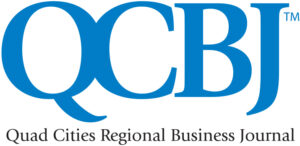Manufacturing is a key pillar of Illinois’ economy. And manufacturing in the Illinois Quad Cities region – which pumps $6 billion into the region’s economy each year – is the epicenter of manufacturing in Illinois.
That was the message delivered Tuesday morning, Aug. 23, at manufacturing powerhouse Deere & Co.’s Worldwide Headquarters in Moline as part of the Illinois Manufacturing Association’s (IMA) statewide “Manufacturing Matters Tour.”
“Manufacturing is resilient, manufacturing is diverse, sustainable, innovative … it’s what built our nation,” IMA President and CEO Mark Denzler told a crowd of media representatives and manufacturing and education leaders with one of John Deere’s signature big green machines serving as a backdrop.
The numbers tell the tale, according to the IMA, which bills itself as the only statewide association dedicated to advocating, promoting and strengthening Illinois’ manufacturing sector.
Consider, for example, that in Rock Island County alone, manufacturing generates $4.9 billion in economic output each year. And the total economic output for the metropolitan Illinois Quad Cities from manufacturing is $6 billion when Mercer County’s $303.1 million and Henry County’s $752.5 million are added. That’s according to data collected and analyzed by independent economists at the Darla Moore School of Business at the University of South Carolina. The IMA called it one of the most comprehensive studies of the true impact of manufacturing ever conducted in the state.
“An important takeaway from this study is the sheer size of manufacturing’s economic presence in Illinois,” Joseph C. Von Nessen, research economist at the business school, said in a news release. “Every job created by a manufacturer spurs additional hiring and spending across multiple industries in the state. These secondary economic effects, known as the multiplier effect, represent additional contributions to the economy and should not be overlooked.”
The IMA commissioned the study and launched the tour to spread the message that manufacturing is not only thriving post-COVID, but it remains one of the biggest economic drivers of the region, the state and the nation, Mr. Denzler said.
The total economic impact of manufacturing in Illinois is estimated to be between $580 billion and $611 billion every year, the study found. That’s the largest share of the state’s Gross Domestic Product (GDP) than any industry in Illinois. It’s also true locally. In Rock Island and Henry counties, manufacturing related jobs make up 19% of the overall economy. And in Mercer County, 28% of the economy is either directly or indirectly supported by manufacturing.
The study also shows that in Rock Island County the industry supports 13,050 total jobs. Overall, the metro Illinois Quad Cities supports 16,484 when Henry County’s 2,582 manufacturing-related jobs and Mercer County’s 852 such jobs are added to that total.
In addition, the IMA said, at the state level manufacturing employs 662,298 workers and overall the industry supports as many as 1.7 million jobs, which generate up to $150 billion in labor income for Illinois residents annually. In all, it’s estimated that the industry supports nearly 30% of all jobs in Illinois. And the state also serves as the transportation hub of the nation, sending products around the world.
As well as powering the economy and employing people, Mr. Denzler said, “Illinois manufacturers feed the world, make life-saving products, power our homes and businesses, build our infrastructure, transport people and products around the globe and provide for our nation’s defense.”
And thanks to technological innovation and modern-day factory floors, today’s manufacturing jobs also are not the “dark, dirty, dangerous” ones of the past, Mr. Denzler said. Now it’s important to get that message out as industry leaders look for qualified workers to fill large numbers of open positions.
The IMA said it’s helped to lead those efforts by championing two new manufacturing academies scheduled to open this fall, passing legislation requiring all high schools to offer career and technical education by 2025, and establishing an apprenticeship tax credit for manufacturers that train employees. It also will partner with the Pritzker administration to launch a $7 million manufacturing promotional campaign this fall.
Education leaders also continue to play a major part in finding and training new workers. Locally that includes Black Hawk College (BHC), which has campuses in Moline and Kewanee.
“Partnerships with the Illinois Manufacturers’ Association and area employers strengthen our institution’s commitment to IGNITE local interest in all areas of manufacturing while preparing the skilled workforce our communities desperately need,” said BHC President Tim Wynes of a new program to train at-risk young people for manufacturing jobs.
Organizations like the Quad Cities Chamber also are working to help the IMA spread the good news about manufacturing.
“I am encouraged by the increased activity and problem-solving demonstrated by local manufacturers. Their response to challenges brought on by the pandemic, inflation, and supply chain challenges have me optimistic about the growth of manufacturing in our region,” said Chris Caves, the chamber’s vice president of business and economic growth.
“Manufacturers are stretching their capabilities, researching new markets, investing in innovative technologies, job sharing, reshoring production activities, investing in sustainable energy solutions, and welcoming underrepresented populations into their factories,” she added. “The grit and resilience of Quad Cities manufacturers have them thinking creatively and strategically. We’re a legacy manufacturing community and we are thriving.”




